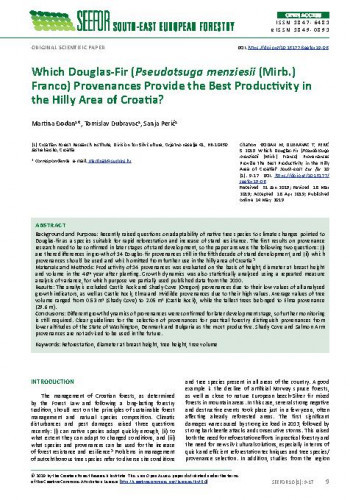Background and Purpose: Recently raised questions on adaptability of native tree species to climate changes pointed to Douglas-fir as a species suitable for rapid reforestation and increase of stand resistance. The first results on provenance research need to be confirmed in later stages of stand development, so the paper answers the following two questions: (i) are there differences in growth of 14 Douglas-fir provenances still in the fifth decade of stand development, and (ii) which provenances should be used and which omitted from further use in the hilly area of Croatia? Materials and Methods: Productivity of 14 provenances was evaluated on the basis of height, diameter at breast height and volume in the 46th year after planting. Growth dynamics was also statistically analysed using a repeated measure analysis of variance, for which purpose we partially used published data from the 2010. Results: The analysis excluded Castle Rock and Shady Cove (Oregon) provenances due to their low values of all analysed growth indicators, as well as Castle Rock, Elma and Hvidilde provenances due to their high values. Average values of tree volume ranged from 0.53 m3 (Shady Cove) to 2.05 m3 (Castle Rock), while the tallest trees belonged to Elma provenance (29.6 m). Conclusions: Different growth dynamics of provenances were confirmed for later development stage, so further monitoring is still required. Clear guidelines for the selection of provenances for practical forestry distinguish provenances from lower altitudes of the State of Washington, Denmark and Bulgaria as the most productive. Shady Cove and Salmon Arm provenances are not advised to be used in the future.
Sažetak

 South-east European forestry : SEEFOR : international scientific journal in field of forestry : 10,1(2019) / editor-in-chief Dijana Vuletić.
South-east European forestry : SEEFOR : international scientific journal in field of forestry : 10,1(2019) / editor-in-chief Dijana Vuletić.